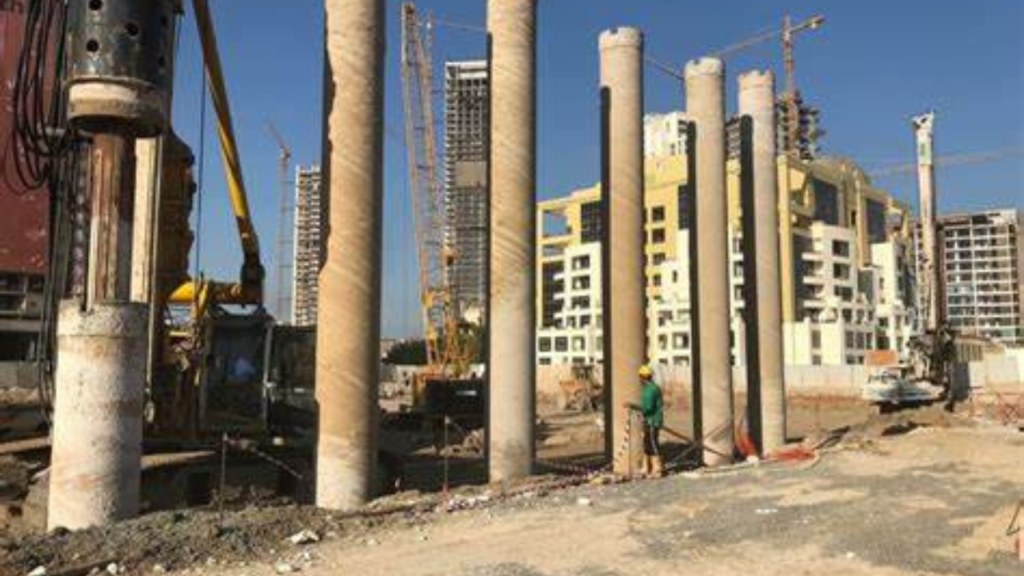In Nigeria, building in certain areas especially those with swampy, soft, or unstable soil comes with a unique set of challenges.
One of the most reliable solutions to these challenges is the piling foundation.
Whether you’re planning a high-rise building in Lagos, a waterfront property in Port Harcourt, or building on a site with weak soil, understanding piling foundation is crucial.
This article breaks down everything you need to know about piling foundations in Nigeria, what it is, when it’s used, the process involved, and what you should expect in terms of cost, time, and technical requirements.
Table of Contents
ToggleSee related – Which foundation is suitable for which soil?
What Is a Piling Foundation?

A piling foundation is a deep foundation system that transfers the load of a building to stronger soil or rock deep underground.
This is done using long, strong columns called piles, which are driven or drilled deep into the earth.
These piles bypass weak surface soils and anchor the building into firmer ground or rock layers far below.
When Is Piling Used in Nigeria?
Piling is usually necessary when:
- The topsoil is too soft, sandy, or swampy
- You’re building in coastal areas (like Lagos Island, Lekki, Warri, Bonny, etc.)
- You’re constructing multi-storey buildings or heavy structures
- There’s a high water table or risk of flooding
- You need to prevent differential settlement (uneven sinking)
Types of Piles Commonly Used in Nigeria
1. Driven Piles:
- Precast concrete, steel, or timber piles that are hammered into the ground.
- Common in Lagos and riverine areas.
2. Bored (Drilled) Piles:
- Holes are drilled into the ground and filled with reinforced concrete.
- Suitable for projects where vibration must be minimized (e.g., near other buildings).
3. Franki Piles:
- A popular method in Nigeria where a steel tube is driven with concrete plugs and then filled with reinforced concrete.
See also – What is raft foundation | advantages and disadvantages
How the Piling Process Works (Step-by-Step)
1. Soil Investigation
A geotechnical engineer conducts a soil test to determine the depth and type of pile needed.
2. Pile Design
A structural engineer designs the pile length, size, spacing, and reinforcement based on the soil report and building load.
3. Mobilization
Heavy machinery like pile drivers or drilling rigs are brought to the site.
4. Pile Installation
- For driven piles: piles are hammered into the ground.
- For bored piles: holes are drilled and filled with concrete and reinforcement.
5. Pile Cap Construction
After piling, a thick concrete cap connects all piles at the top and distributes the load from the building columns.
See also – pad foundations explained | pros and cons
Pros of Piling Foundation
- Stable and reliable on weak or swampy soil
- Prevents differential settlement
- Supports heavy structures and multi-storey buildings
- Long-lasting and durable
- Can be used in waterlogged areas
Cons of Piling Foundation
- Expensive compared to shallow foundations
- Requires heavy machinery and skilled professionals
- Time-consuming
- Can disturb nearby buildings (especially with driven piles)
What to Expect (As a Landowner or Developer)
1. Cost
Piling is expensive. Expect to spend between ₦20,000 to ₦50,000 per meter of pile depending on:
- Pile type
- Soil conditions
- Building size
- Location
For an average residential building, piling can add millions of naira to your construction cost.
2. Timeframe
Piling can take 1 to 4 weeks, depending on the number of piles and site conditions.
3. Required Experts
- Soil engineer (for geotechnical tests)
- Structural engineer (for pile design)
- Piling contractor (for execution)
4. Approvals
You may need to submit your soil test and pile design to local authorities before starting, especially in urban areas like Lagos or Abuja.
See also – Strip foundation explained to common man
Areas in Nigeria Where Piling Is Common
- Lagos Island, Lekki, Ajah, Ikoyi
- Port Harcourt, Bonny, Warri
- Bayelsa and other Niger Delta states
- Coastal areas or areas with reclaimed land
- Flood-prone zones or lands with poor bearing capacity
Conclusion
Piling foundation is a lifesaver for buildings on difficult soils in Nigeria.
While it may cost more upfront, it prevents future structural problems, especially in swampy or flood-prone locations.
If your land is in such an area, don’t compromise piling might be your best investment for a safe and durable structure.
Before you begin, always conduct a proper soil test and work with certified professionals to avoid costly mistakes.
See also – How do you solve foundation problems to avoid building collapse?
Frequently asked questions
What is a piling foundation, and how does it work?
A piling foundation is a type of deep foundation that uses long, slender columns (piles) driven deep into the ground to transfer the load of a structure to stable soil layers or bedrock.
Piles bypass weak or unstable surface soils, ensuring the building’s stability.
Why are piling foundations commonly used in Nigeria?
Piling foundations are essential in Nigeria due to the diverse soil conditions across the country.
In areas with weak, swampy, or expansive soils, such as the Niger Delta, piling foundations provide the necessary support for buildings and infrastructure.
They are also used for large or heavy structures that require additional stability.
What types of piles are used in Nigerian construction projects?
Common types of piles include:
- Concrete Piles: Precast or cast-in-situ piles made of reinforced concrete.
- Steel Piles: Strong and durable, often used for heavy loads or in marine environments.
- Timber Piles: Used for lightweight structures, though less common today.
- Composite Piles: A combination of materials like concrete and steel for enhanced performance.
What are the advantages of using piling foundations in challenging soil conditions?
Piling foundations provide stability by transferring loads to deeper, stronger soil layers.
They minimize settlement issues, support heavy structures, and are suitable for areas with high water tables or poor surface soils.
Piles also allow construction on sites that would otherwise be unsuitable for traditional foundations.
Are there any disadvantages or challenges associated with piling foundations?
Piling foundations can be expensive due to the specialized equipment and expertise required.
The installation process may cause noise and vibrations, which can be disruptive in urban areas.
Additionally, improper design or installation can lead to structural issues.








2 thoughts on “All about piling foundation in Nigeria – What to expect”
Your blog is a testament to your expertise and dedication to your craft. I’m constantly impressed by the depth of your knowledge and the clarity of your explanations. Keep up the amazing work!
Thanks